The main mistakes made when installing the boiler
If the homeowner decides to independently connect the storage water heater, under no circumstances should the following things be done:
- replace the components supplied with the device;
- connect the device to the AC mains in the absence of water in the tank;
- disassemble the device when connecting the water heating device to the electrical network;
- turn on or use an ungrounded appliance;
- operate equipment with inappropriate water pressure parameters in the central water supply;
- carry out a complete drain of water from the tank during the operation of the storage boiler.
And most importantly, under no circumstances should safety precautions be neglected when connecting a boiler - a sufficiently powerful electrical appliance. If you have any doubts about the correctness of independent installation work, it is advisable to seek help from professionals.
To understand what water heaters are, how to connect such devices and what are the benefits of using them, you do not need to be a professional electrician or builder. All installation work is within the power of every person who is at least a little familiar with the plumbing device and knows how to understand the simplest electrical circuits. The main thing is attentiveness, adherence to all safety rules and, of course, desire, without which it is better not to undertake such work on your own.
The procedure for connecting a water heater - preliminary work
Preliminary work begins with the installation of a water heater. And first you need to choose the optimal location of the column or boiler.
The first type of heating devices - a column - should be located near a free valve of a household gas pipeline (no further than 2-3 meters), in a well-ventilated room.
The storage boiler can be installed literally anywhere. After all, electricity and water can be supplied anywhere. But before connecting boiler to the water supply it is necessary to take into account the heavy weight of the filled heater and the cumulative "character" of this device, which limits the amount of hot water consumed.
Having decided on the location of the water heater, you need to attach the column or boiler to the supporting surface. For a boiler, this stage is as follows:
- Holes are drilled in the wall for anchor bolts, the position of which can be determined by "fitting" an empty (and light) water heater to the surface.
- Next, the boiler is "applied" to the wall, driving in the holes through the lugs in the heater brackets, fastening anchors.
- After that, you simply tighten the anchor bolts, securing the fasteners in the hole.
- Finally, you connect the heater to the mains. To do this, it is advisable to take a separate line from the central panel using a 4 mm three-core cable. Well, as a plug and socket, a separate residual current device should be used - a fuse to which the electric line and cord from the boiler are fed. Moreover, the installation of a separate line and an RCD must be completed before connecting the boiler to the water supply.

A gas water heater requires a lot of trouble:
- First, you stuff a galvanized sheet on the wall, the dimensions of which coincide with the supporting edge of the column case. However, galvanizing can be replaced with tiles or fire-resistant plaster.
- Next, you "try" the speaker against the wall, marking the location of the fasteners along the lugs on the brackets of your speaker cabinet.
- The next step is to drill the mounting holes.
- Next, you mount the column on the anchor bolts, driving them through the lugs and tightening them all the way.
- The last stage - connecting the dispenser to the gas pipeline - is performed only by a representative of the territorial gas industry. Self-connection can provoke an accident or a fine for illegal tapping into a gas pipeline.

After completing the installation of the heater, you can proceed to the insert in the "cold" water supply.
Preparing to connect
When planning to do the installation of a boiler with your own hands, you need to carefully work out a work plan. This stage is very important and any mistake made by the master can complicate the further process.

The stage includes the following actions:
- The wizard performs the calculation and selects the necessary anchors. The thickness of the fastening bolts is set according to the weight of the filled tank. Since the fasteners will be constantly under load, you need to give an error in the calculation. It is better to take massive anchors.
- A hole is made in the wall and a metal base bar is screwed to it. The unit will hang on it.
- A metal strip is attached to the heating device, which is mounted on the wall. For reliability, it is tightened with bolts.

It should be borne in mind that the heater must be located strictly horizontally or vertically. Even a slight tilt is unacceptable, because the markup is carried out using the mounting level. After completing the preparatory work, they begin to connect the device to the water supply system.

Electrical connection
To begin with, we want to acquaint you with the basic rules for connecting a water heater to the electrical network. Compliance with these recommendations will allow the installation to be carried out as safely and efficiently as possible.
- The boiler socket must be located in a place inaccessible to splashing water. Experts strongly advise using special waterproof sockets for these purposes.
- The water heater can only be turned on when the ground is connected to the electrical outlet. This can be done using a three-core wire (in this case, the socket must also be designed for three poles).
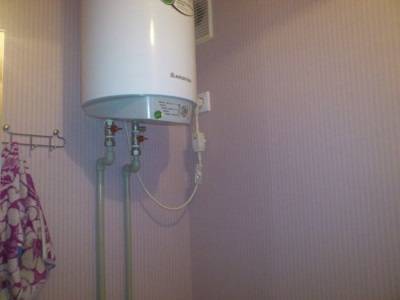
After making sure that all safety rules are followed, you can start directly to work. The procedure will be as follows:
- we measure the distance between the installation site of the water heater and the outlet;
- we disassemble the plug of the device into elements;
- remove the insulating material from the cable;
- we clean the veins with side cutters;
- armed with a soldering iron, we connect the conductors to the plug contacts (red - to the phase, yellow / green / black - to the ground; blue - to zero);
- remove the water heater panel and open the contacts;
- we clean the cores at the opposite end of the cable;
- we connect them to the contacts of the device and return the panel to its place.

You can connect to the mains in a different way - connect the water heater directly to the switchboard. In this case, you need to act as follows:
- we lay the cable from the device to the electrical panel;
- install an automatic machine near the water heater;
- we pass the cable through the machine;
- remove about 100 mm of insulating material from the cable;
- we strip the phase from the machine;
- we connect the phase from the machine to the upper terminal, and from the water heater to the lower one;
- remove the insulating material at both ends of the cable, release the cores;
- remove the boiler cover, connect the wires to the terminal of the device;
- turn off the current supply and connect the heater to the electrical panel.

The following video shows the water heater connection diagrams and their descriptions, which will help you figure out how to connect the boiler correctly.
What is required for installation?
Before installing an electric or gas boiler, it is necessary to allocate a suitable place for it, taking into account the following points:
- placement of a water heater in an apartment or a private house should be done taking into account ease of use and maintenance;
- it must be foreseen that when emptying or repairing the apparatus, a significant part of the water may spill onto the floor;
- it is convenient to connect the water heater on your own when the water supply and electrical network passes nearby and in the same room;
- do-it-yourself installation and connection of a gas boiler involves connecting a pipeline supplying natural gas to the room.

Based on the listed conditions, the installation and connection of a storage water heater can be performed in the following rooms of a private house or apartment:
- kitchen - above the sink;
- bathroom - above the bathroom;
- boiler room - above the tiled floor.
Before deciding how to connect the boiler to the water supply, you need to hang it from the wall. To complete all work, you will need an electric drill with an impact function (or hammer drill), carbide-tipped drills and a standard set of locksmith tools, including a gas and adjustable wrench. The boiler connection diagram is assembled from the following elements and materials:
- non-return valve with a safety one in one body (as a rule, it comes with a boiler);
- bronze tee DN 15 (1/2 ");
- ball valve DN 15 (1/2 ") - 3 pcs., 2 of them - with American;
- pipes for connection (usually metal-polymer);
- FUM tape, flax or a special thread for sealing joints.
There is also an electrical diagram for connecting the boiler, according to which it is necessary to purchase differential circuit breakers for a current of 16 A (2 pcs.), A socket and a plug with an earthing contact, as well as a power cable of the required length. The connection of the apparatus operating on natural gas is carried out by means of a gas hose.
Features of connecting a flow-through boiler
The flow-through design of an electric boiler, as in the photo, is installed directly into the branch of the water supply system provided for supplying hot water.
- The water supply in the central pipeline is shut off.
- At the point of insertion of the heating device, the pipe is cut, forming a gap.
- At the ends of the gaps, shut-off valves are attached, which in the future will allow for repairs without blocking the central water supply.
- On the inlet and outlet nozzles of the flow-through water heating system, hoses are wound that connect the boiler with shut-off valves.
When independently carrying out work on dismantling the heating equipment, instead of the central water supply, the tap installed at the inlet pipe is shut off and only after that at the outlet. Also, in the process of using a flow-through water heating device, first of all, water is turned on and only after that the heating device. If there is no need for hot water, then turn off the power supply, and then the water.
It is not so difficult to figure out how to properly connect the boiler, the main thing is to have a desire. But for greater confidence, you can practice on pipe scraps so as not to spoil the main elements of the system. This will allow you to gain experience and avoid stupid and unnecessary mistakes.
Examples of connecting the boiler to the water supply






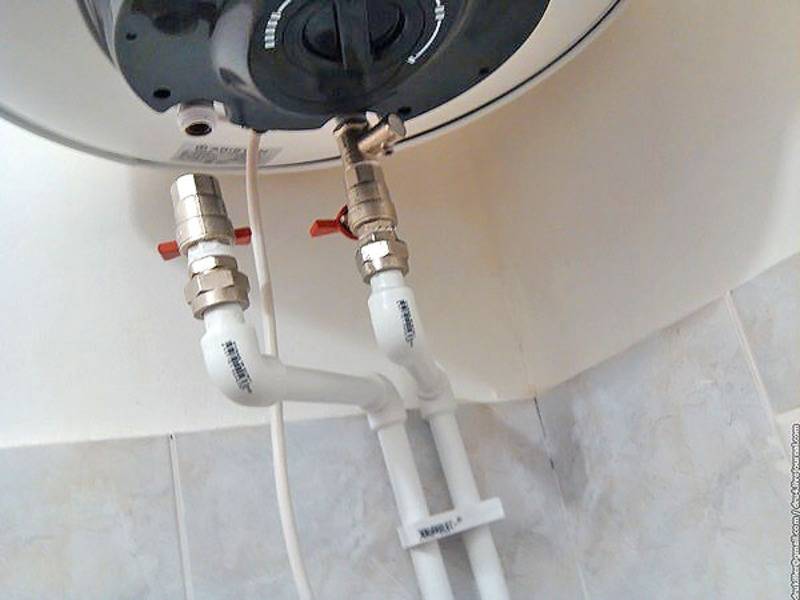

Step-by-step instructions for installing a storage boiler
The storage boiler installation scheme is a little more complicated. Here you need to correctly lay out the piping, firmly fix the tank, and make the wiring connection.
Choosing a place for the tank and its installation
The storage tank takes up a certain place in the room, so it must be effectively placed so as not to take up unnecessary space. But at the same time, the boiler should be located as close as possible to the taps.The remote location of the taps from the heater increases the waiting time for hot water to arrive.
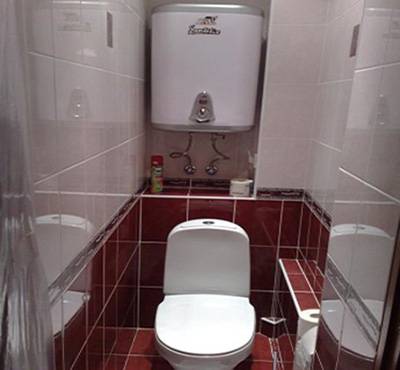
Convenient placement of the storage boiler with a separate bathroom
The place of attachment is chosen according to the layout of the room:
- the layout in a private house is different from that of an apartment. Here, the bathroom, toilet and kitchen can be far apart, and one boiler must supply hot water to all rooms. Here it is necessary to determine an important room, where heated water should be supplied first of all and install a water heater closer to it;
- the traditional layout of the apartment provides for a combination of all these rooms, so it will be easier to choose the location of the tank here.
Most often, the tank is installed above the toilet. It does not take up useful space and is close to the sewer, which makes it convenient to bleed water from the safety valve. The unit is attached to the wall with anchors. The water tank is heavy, so if the wall is loose under it, an additional support is welded from the profile pipe.
Plumbing connection
The best connection option is considered to be a circuit with the possibility of draining water from the tank.

The step-by-step execution of work looks like this:
- The house is disconnected from the cold water supply, and the hot water riser is additionally blocked in the apartment. The collection of all the nodes of the circuit begins from a water heater suspended on the wall. To seal the connections, tape or FUM tape is wound on the thread.
- There are two threaded connections at the bottom of the tank. On the right is the cold water inlet marked in blue, and on the left is the hot water outlet marked in red. The package starts with cold water.
- A brass tee is screwed onto the inlet pipe. It must be turned with a transverse hole in a convenient direction to drain the water. A ball valve is screwed into the same hole through a brass adapter. A branch pipe with a hose for draining water is connected to it. A ball valve is also screwed into the downward thread of the tee to turn off the supply of cold water to the inside of the container.
- Now it is the turn for the most important - the safety knot. The boiler is equipped with a safety valve, which is mounted immediately after the bottom tap on the tee. To install it correctly, there is a directional arrow on the body. There is a water bleed nipple on the side of the valve. A transparent reinforced hose is attached to it with a clamp and lowered into the sewer.
- Native valves are not always reliable, so they often buy a separate "safety group". It consists of a non-return valve mounted on the tap, coming out of the lower thread of the tee. The safety valve is placed separately on the middle outlet of the tee.
- Next, it remains to bring cold water. This can be done with any pipes, for example, metal-plastic or ecoplast, if desired. In order not to cut the pipe of the main water supply, the connection can be made through a tee by installing it on the threaded connection of the toilet tank or the water tap of the washbasin.
- The hot water unit is assembled similarly to cold water only without a valve. In a private house, from the outlet of hot water from the boiler, the piping is laid to the taps. In the apartment, the outlet of the water heater is connected to the hot water supply pipeline. In this case, when the boiler is operating, the tap on the riser supplying centralized hot water is closed.
On this, the water heater is connected to the water supply system, it remains to supply the electrical wiring and can be used for its intended purpose.
Connection to different types of pipes
It should be borne in mind that the scheme for connecting the boiler to the water supply system may differ. It depends on the pipes. The most difficult work will be if steel pipes are installed in the apartment. It is difficult to shorten or lengthen them without additional equipment. The master may need a grinder and other equipment. Each case is discussed in detail in the video.

Polypropylene pipes
To carry out the work, you will additionally need a soldering iron and a wood file. Tees and couplings for connections must be selected from the starting material.Polypropylene metal threaded coupling is the best solution, it is reliable.
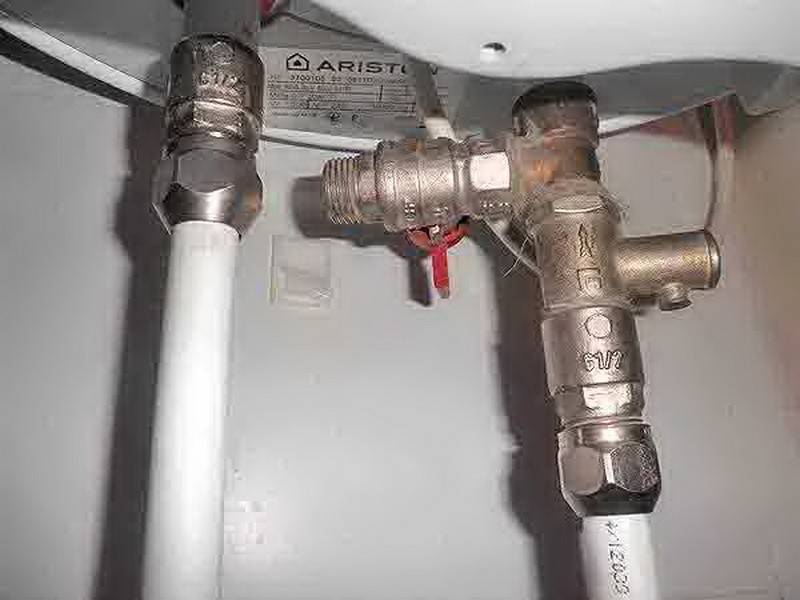
The work process is simple if the pipes are on the surface. If the communications are embedded in the wall, the top covering will have to be opened to carry out the work. It is impossible to make a connection without disturbing the finish. This will require additional expenses from the owner of the apartment for cosmetic repairs.
Reinforced-plastic pipes
Pipes made of metal-plastic most often pass along the surface, so there is no need to additionally groove the walls. Fittings are required for installation. Any connection scheme can be used. Tees are used for tapping. A heating device is connected to them through auxiliary pipes or flexible pipes.
Steel pipes
It is possible to do without the use of welding when working with steel pipes. To do this, you will have to buy a special tee. It looks like a clamp with a branch. The principle of use is simple, it is put on the pipe and the position is fixed with clamps. A sealant is used for a snug fit. Do not use dry welding for this purpose. The reliability of this substance is not enough for the full operation of the system.

Before installing the adapter, the pipes must be thoroughly cleaned of dirt, rust and traces of old paint. A threaded hole is made in the pipeline. It is needed to connect the tap and the underwater hose.
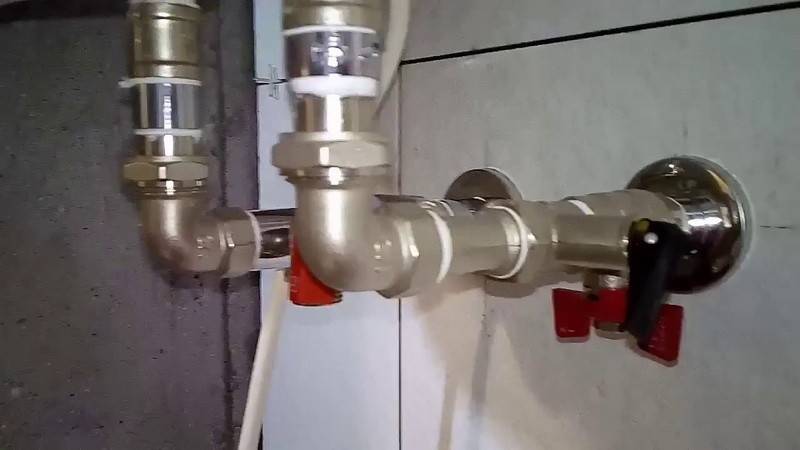
Connection sequence
A safety valve is required when installing the heater. It will reduce the risk of a hazardous situation and ensure the full operation of the device.

When providing self-installation, proceed as follows:
- a tee is connected to the pipe;
- cut in the shut-off valve to bleed off the remaining water;
- connect the tap to the adapter;
- connect a fuse with a drainage tap;
- install a shut-off valve.

In some cases, a filter and a thermostat are connected. A special filter is required if the water in the pipeline is hard. It will prevent the formation of scale on the heating element and the walls of the container.
The principle of taking water from the tank
There is one correct scheme for connecting a storage water heater, taking into account the peculiarities of its design and allowing, if necessary, to quickly empty the tank. This need arises for the following reasons:
- scheduled cleaning of the tank and heating element from scale;
- the occurrence of a malfunction;
- moving or replacing the device with a new one;
- emptying the water heater in the country or in a house with periodic heating in winter.
The connection of the water heater to the water supply system, the scheme of its installation and placement should take into account that water is taken from the upper zone of the tank. This is due to the fact that the water is the hottest at the top, and the cold flow is replenished to the lower zone if there is a draw-off in the DHW system. The selection takes place through a vertical tube, the cut of which is located precisely in the upper zone.

It should not be allowed that the water from the tank could return to the cold water supply system, therefore, the boiler is connected to the water supply through a check valve. If the pressure in the network drops as a result of the shutdown of the water, the valve will not allow the contents of the tank to flow back into the pipe.
As a result of the standard connection of the boiler to the water supply, it cannot be quickly emptied by opening a hot water tap. Even unscrewing the hot water pipe from the fitting will not have an effect, since the water intake is too high, and there is a check valve on the cold one. The problem of draining is solved by a simple diagram of connecting the water heater to the water supply system, which is assembled at the stage of installing the device.
Preparation
If you have not previously installed the boiler, then first of all decide on its future location, then select the tool and materials.
Seat selection
When searching, be guided by the following guidelines:
- The wall must be strong, better load-bearing to support the large weight of the tank (add the weight of water to the weight of the device).
- Free access to communications and to the device is important, since the water heater will have to be serviced in the future.
- Do not connect the boiler to bad wiring. Typically, the power of the models is from 3 kW.
- Do not connect the tank to rotten or rusty pipes.
- Choose a location close to the pipeline so that you do not have to bump into the system from the next room.
- An acceptable choice for installation is a bathroom or kitchen, less often a toilet or an entrance hall.
In fact, everything is not so difficult. Regular quality wiring will easily withstand a medium power electric heater. There are no requirements or restrictions on the installation of this device.
We still recommend running a separate line from the meter to the tank to relieve the main wiring.
Instruments

Tools and materials needed to install the boiler.
If you do everything from scratch, then you have to sweat. To begin with, cut into a pipeline with cold water, make a wiring for hot water, and only then proceed to connect an indirect heating boiler. You will also need special tools and materials:
- metal-plastic pipes;
- tow;
- paste;
- sealed tape;
- flexible hoses for connecting the boiler and water supply;
- tees;
- Ball Valves;
- check valve;
- perforator (a drill is recommended only for lovers of masochism, since you will have to drill rather deep holes in a strong concrete wall);
- roulette;
- level;
- screwdriver;
- gas or adjustable wrench;
- a set of regular keys.
Boiler installation.
Using the method described below, you can connect a storage water heater from companies such as Elenberg, Eltron, Etalon, Ferroli, Gorenje, Polaris, Stiebel, Thermex, Vega, Termeks, Ariston, Atmor and others. It is considered the most effective option for connecting a simple vertical boiler, but first, let's figure out the design of the device.
The boiler consists of the following parts:
- TEN - an element that heats water;
- Tank - keeping the water temperature at the required level;
- Thermostat;
- Water drainage and supply systems.
The most important thing when choosing a boiler is the way it is attached to the wall (vertical or horizontal), and the volume of the tank. Most often, it is vertical devices that are used: they take up less space than horizontal water heaters and are connected to the water supply system much easier and faster
Indirect heating boiler - what kind of unit?
This phrase means a tank filled with water, which is equipped with a coil-heat exchanger inside, connected to the boiler, which is responsible for heating the house, or to another system inside which some kind of coolant circulates. The water in such a unit becomes hot due to the fact that the liquid coming directly from the boiler to the heat exchange coil gives up its energy to the liquid, which is in the boiler tank itself. That is, it is not heated directly, but only absorbs heat from another source. Hence the name for this unit was formed - an indirect heating boiler.
The water heated in the unit can be used for a wide variety of household needs. Moreover, it remains in a heated state for a long time, since the system itself maintains the desired temperature level. You can install such a boiler, by the way, not only in a cottage, but also in an apartment, hotel or other room.
The boiler itself is a metal or plastic container of parallelepiped shape or cylindrical. The capacity of the tank can be anything and sometimes amounts to thousands of liters.
The water tank is usually enclosed in another housing, with thermal insulation material often interposed between these two structural elements. It helps to retain heat for longer and also protects the outer casing of the tank from strong heat. The water, which is directly responsible for heating the liquid in the boiler tank, is usually circulated through a heat exchanger coil. The elements of the tank are protected from corrosion by the presence of a magnesium anode.To control the pressure in the unit, a so-called safety valve and a thermostat are provided. The circulation of water is due to the presence of a special pump system.
So BKN is a kind of "thermos" for water in the house. He himself does not heat the water, but is able to keep the liquid heated by means of a heat carrier in a warm state.
Self-installation of the boiler
You can install an electric boiler yourself. This will require plumbing and electrical work.
Preparatory stage

This stage of work includes calculating the amount of water consumed, choosing a suitable place for the device (it is necessary that the user can easily get to all the connecting elements of the system to simplify maintenance of the device).
If the boiler is accumulative, you need to make sure that the wall can support its weight with water (too thin or plasterboard partitions will definitely not work). The closer the device is to the water supply pipes, the better, since there is no need to lay an additional section of the water supply pipeline.
For work you will need:
- building level;
- ruler or tape measure;
- puncher;
- adjustable wrench;
- pliers;
- tees-fittings;
- shut-off valves;
- connecting hoses (for water drainage);
- additional pipes (if necessary), you must first make sure that the pipes are able to withstand the required load;
- sealing tape, tow or special paste (for sealing the connecting elements).
After making sure that the place is chosen correctly and that all the necessary materials and tools are available, you can proceed directly to the installation, working according to the ready-made scheme.
Installation and connection of the water heater
The first thing to do is to attach the device to the attachment point: the distance between it and the ceiling must be at least ten centimeters, otherwise it will be simply impossible to hang the tank on the fasteners.
The attachment points are carefully marked (with a pencil or marker). At the marked points, you need to drill holes and tighten the fasteners to the desired depth.

The photo shows the main elements of connecting the boiler
For fastening, it is better to use the steel hooks that come with the device. If they are not provided, then the mount must be selected based on the weight of the boiler. After that, the tank is hung on them using the grooves specially provided in its body.
Before installing the tank, you need to make sure that everything is in order with the threaded connections, since they are often unscrewed by 1-2 turns. In this case, it is recommended to drive the threads with a 1/2 "ram, but carefully, without excessive force.

Next, the device is connected to the water supply. These work may have their own characteristics and differences depending on what material the pipeline is made of.
For polypropylene, metal-plastic and steel pipelines, you will need to use a special tool designed specifically for work on each of these materials. Also, for tapping into the pipeline, you will need to select various auxiliary parts (tees, couplings and fittings).
But the order of work is the same in all cases. First, shut off the water supply. The pipe is cut, a branch is installed at the cut. To do this, a tee is soldered into the pipeline. The pipe bends are equipped with an MPH coupling, to which a shut-off valve is connected. The shut-off valve is connected to the boiler nozzles directly or using flexible hoses.
Installation of valves
To ensure the supply of water to the tank from the cold pipeline, the following steps are performed:
- installation of the tee on the tank branch pipe;
- connection of the drain valve to the side of the tee;
- installation of a non-return or explosive valve on a tee;
- shut-off valves are mounted in series behind the valve;
- connection of valves to the water supply system.
These manipulations are recommended to be performed at the branch from the central pipeline. This will prevent damage to the draw-off devices during installation.
